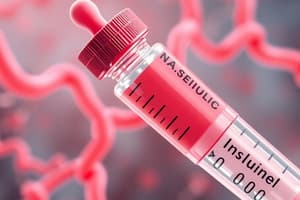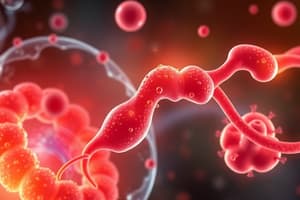Podcast
Questions and Answers
Which of the following is the primary characteristic differentiating type 2 diabetes from type 1?
Which of the following is the primary characteristic differentiating type 2 diabetes from type 1?
- Onset preceded by a viral infection in childhood.
- Decreased insulin secretion and/or insulin resistance. (correct)
- Presence of islet cell antibodies leading to beta-cell destruction.
- Total dependence on exogenous insulin.
A patient is diagnosed with metabolic syndrome. Which underlying pathophysiological process most significantly increases their risk for developing type 2 diabetes?
A patient is diagnosed with metabolic syndrome. Which underlying pathophysiological process most significantly increases their risk for developing type 2 diabetes?
- Autoimmune destruction of pancreatic beta cells.
- Impaired glucagon secretion.
- Excess circulating fatty acids. (correct)
- Elevated levels of circulating ketones.
Which combination of assessment findings would lead a nurse to suspect a patient has undiagnosed type 2 diabetes?
Which combination of assessment findings would lead a nurse to suspect a patient has undiagnosed type 2 diabetes?
- Hypoglycemia, tremors, and anxiety.
- Increased thirst, frequent urination, and recurrent infections. (correct)
- Bradycardia, constipation, and weight gain.
- Weight loss, decreased appetite, and normal blood glucose.
A patient's fasting plasma glucose level is 120 mg/dL during a diabetes screening. What does this result indicate?
A patient's fasting plasma glucose level is 120 mg/dL during a diabetes screening. What does this result indicate?
A nurse is developing an education plan for a newly diagnosed patient with type 2 diabetes. What initial action should the nurse take to promote the patient's active participation?
A nurse is developing an education plan for a newly diagnosed patient with type 2 diabetes. What initial action should the nurse take to promote the patient's active participation?
Which method is most effective for a nurse to assess a patient's comprehension of recently taught diabetes management strategies?
Which method is most effective for a nurse to assess a patient's comprehension of recently taught diabetes management strategies?
Besides the typical symptoms of diabetes, what other common clinical manifestations should a nurse assess for in a patient suspected of having type 2 diabetes?
Besides the typical symptoms of diabetes, what other common clinical manifestations should a nurse assess for in a patient suspected of having type 2 diabetes?
What is the significance of identifying risk factors associated with diabetes?
What is the significance of identifying risk factors associated with diabetes?
A nurse is explaining the diagnostic criteria for diabetes at a health fair. Which statement accurately describes one of the criteria?
A nurse is explaining the diagnostic criteria for diabetes at a health fair. Which statement accurately describes one of the criteria?
In a client with type 2 diabetes, what is the underlying cause of metabolic abnormalities?
In a client with type 2 diabetes, what is the underlying cause of metabolic abnormalities?
What factors related to diabetes can be inherited?
What factors related to diabetes can be inherited?
If a patient's A1C test result is 6.5%, what does this imply about their diabetic status?
If a patient's A1C test result is 6.5%, what does this imply about their diabetic status?
When screening a patient for diabetes, what key assessments should the nurse prioritize?
When screening a patient for diabetes, what key assessments should the nurse prioritize?
Which of the following is the normal range for Normal Blood Glucose?
Which of the following is the normal range for Normal Blood Glucose?
Which of the following is NOT considered one of the three main contributing factors in theory, that lead to Diabetes Mellitus?
Which of the following is NOT considered one of the three main contributing factors in theory, that lead to Diabetes Mellitus?
Flashcards
Diabetes Mellitus
Diabetes Mellitus
A chronic multisystem disease primarily involving a disorder of glucose metabolism.
Possible Causes of Diabetes
Possible Causes of Diabetes
Genetic, autoimmune, and environmental factors.
Polydipsia
Polydipsia
Increased thirst
Polyuria
Polyuria
Signup and view all the flashcards
Polyphagia
Polyphagia
Signup and view all the flashcards
Other Type 2 Diabetes Symptoms
Other Type 2 Diabetes Symptoms
Signup and view all the flashcards
Metabolic Syndrome
Metabolic Syndrome
Signup and view all the flashcards
Insulin Resistance Syndrome
Insulin Resistance Syndrome
Signup and view all the flashcards
Diabetes Diagnosis Methods
Diabetes Diagnosis Methods
Signup and view all the flashcards
Focused Assessment for Diabetes
Focused Assessment for Diabetes
Signup and view all the flashcards
Assess Patient Understanding
Assess Patient Understanding
Signup and view all the flashcards
Type 2 Diabetes Risk Factors
Type 2 Diabetes Risk Factors
Signup and view all the flashcards
Type 2 Diabetes vs Type 1
Type 2 Diabetes vs Type 1
Signup and view all the flashcards
Newly Diagnosed Patient
Newly Diagnosed Patient
Signup and view all the flashcards
Fasting plasma glucose of 120 mg/dl
Fasting plasma glucose of 120 mg/dl
Signup and view all the flashcards
Study Notes
- Normal blood glucose levels range from 70-100 mg/dl.
- Diabetes mellitus is a chronic, multisystem disease.
- Primarily a disorder of glucose metabolism, diabetes is caused by genetic, autoimmune, and environmental factors.
- The ADA recognizes 4 classes of diabetes.
Diabetes Fast Facts
- 30.3 million people have diabetes.
- 23.1 million people are diagnosed.
- 7.2 million cases are undiagnosed.
- Type 2 diabetes accounts for 90-95% of all diabetes cases.
- Type 2 diabetes differs from type 1 diabetes primarily because there is decreased insulin secretion and/or resistance to produced insulin.
Risk Factors for Diabetes
- Type 1 diabetes is an autoimmune disease.
- Type 1 diabetes can be genetically inherited or triggered by environmental factors like viruses.
- Type 2 diabetes risk factors:
- Being overweight or obese
- Older age
- Family history
- Metabolic abnormalities
- Prediabetes
Metabolic Syndrome
- Metabolic Syndrome is also known as insulin resistance syndrome.
- Pathophysiology is related to excess circulating fatty acids.
- Metabolic syndrome increases the risk for developing Type 2 diabetes.
- There are 5 main components to Metabolic Syndrome, refer to Chapter 45 in Lewis textbook.
Symptoms of Diabetes
- The 3 P’s:
- Polydipsia (excessive thirst)
- Polyuria (frequent urination)
- Polyphagia (excessive hunger)
- Symptoms related to Type 2 diabetes:
- Hyperglycemia (high blood sugar)
- Fatigue
- Recurrent infections
- Prolonged wound healing
Type 2 Diabetes signs and symptoms
- Onset typically occurs after 40 years of age.
- Obesity is a common characteristic.
- Patients are not typically prone to diabetic ketoacidosis.
Diagnostic Studies
- Purpose: diabetic screening
- Diagnosis is made using 1 of 4 methods:
- A1C of 6.5% or higher
- Fasting plasma glucose (FPG) of 126 mg/dl or greater
- A 2-hour plasma glucose level of 200 mg/dl or greater during an OGTT (oral glucose tolerance test)
- A patient with classic symptoms of hyperglycemia and a random plasma glucose level of 200 mg/dl or greater
- Criteria 1 through 3 require confirmation testing.
- A fasting plasma glucose of 120 mg/dl indicates prediabetes.
Nursing Responsibilities
- Focused assessment:
- Client height and weight
- BMI
- Abdominal circumference
- Urine sample
- Health history
- Activity level
Patient Education
- When formulating an education plan for a patient newly diagnosed with type 2 diabetes, first assess the patient’s understanding of what it means to have diabetes.
- The best way to assess patient understanding of a recent teaching is to have the patient teach-back the content just taught through verbal or physical demonstration.
Studying That Suits You
Use AI to generate personalized quizzes and flashcards to suit your learning preferences.




